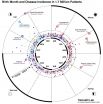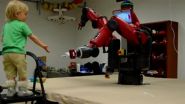(Press-News.org) A new study gives insight into the mental health of children and teens with Down syndrome and the behavioral medications that medical caregivers sometimes prescribe for them.
The Cincinnati Children's Hospital Medical Center study shows that teens and young adults between the ages of 12 and 21 were significantly more likely to be on psychotropic medications than children 5 to 11 years old. Among children less than 12, the odds of being on a psychotropic medication increased with age for all classes of medications studied. For 12 to 18 year olds, the odds of being on a stimulant significantly decreased with age, while the odds of being on a medication from other classes of drugs remained stable over time.
"Variations in medication use over time in children and teens with Down syndrome suggest that the type and severity of neurobehavioral problems likely change over time, too," says Julia Anixt, MD, a developmental pediatrician at Cincinnati Children's and a co-author of the study.
The study is published online in the Journal of Developmental & Behavioral Pediatrics.
In the younger age group, the odds of being on a stimulant increased 1.37 times for each additional year of age from 5 to 11. This means that a 9 year old would be 3.5 times as likely to be on a stimulant medication as a 5 year old. These drugs are used as first-line therapy for symptoms of attention-deficit hyperactivity disorder (ADHD). This increase in use "may reflect increasing impairment in functioning due to ADHD symptoms as children approach 11 years. After that age, the use of stimulants declined with each increasing year."
The researchers found a trend of increasing use of selective serotonin reuptake inhibitors (SSRIs), a medication class commonly used to treat symptoms of anxiety and depression, as children and teens age. Declining behavioral problems (outwardly disruptive behaviors) and increasing emotional problems, such as depression and anxiety, with age are also common in typically developing children and those with intellectual disability.
Use of atypical antipsychotics (AAP) peaked in the age range of 11 to 14, which is an age range that previous studies have identified as consistent with a peak in challenging behaviors in children with Down syndrome. AAPs are approved for the treatment of irritability and aggression in children with autism spectrum disorders but are often prescribed "off-label" to target problem behaviors in children with disruptive behavior disorder and developmental disabilities. The study found that the rates of AAP use in boys was higher than in girls for all ages.
The study included data on 832 children taken between 2010 and 2013. All were patients at Cincinnati Children's. The division of Developmental and Behavioral Pediatrics at Cincinnati Children's is home to The Thomas Center, a specialized clinical program for the care of children with Down syndrome.
"Providers must be more systematic in the screening, diagnosis and management of mental health conditions in children and teens with Down syndrome," says Dr. Anixt. "Eventually, the American Academy of Pediatrics health guidelines for children with Down syndrome could be expanded beyond physical health conditions to include treating behavioral and mental health conditions - thus improving the long-term outcomes and quality of life of individuals with Down syndrome."
INFORMATION:
Co-authors of the study include Anna J. Esbensen, PhD, Susan Wiley, MD, and Jareen Meinzen-Derr, PhD, all of Cincinnati Children's. Alison Downes, MD, co-authored the study while a fellow at Cincinnati Children's. She is now at Children's Hospital of Philadelphia.
NEW YORK, NY (June 8, 2015) - Columbia University scientists have developed a computational method to investigate the relationship between birth month and disease risk. The researchers used this algorithm to examine New York City medical databases and found 55 diseases that correlated with the season of birth. Overall, the study indicated people born in May had the lowest disease risk, and those born in October the highest. The study was published in the Journal of American Medical Informatics Association.
"This data could help scientists uncover new disease risk factors," ...
PROVIDENCE, R.I. [Brown University] -- Researchers from Brown University are developing a new algorithm to help robots better plan their actions in complex environments. It's designed to help robots be more useful in the real world, but it's being developed with the help of a virtual world -- that of the video game Minecraft.
Basic action planning, while easy for humans, is a frontier of robotics. Part of the problem is that robots don't intuitively ignore objects and actions that are irrelevant to the task at hand. For example, if someone asked you to empty the trashcan ...
Researchers at the University of Illinois at Urbana-Champaign have uncovered physical mechanisms allowing the manipulation of magnetic information with heat. These new phenomena rely on the transport of thermal energy, in contrast to the conventional application of magnetic fields, providing a new, and highly desirable way to manipulate magnetization at the nanoscale.
"In our study, we make use of the fact that a heat current passing through a magnetic material creates a separation of electron spins. This process creates a current of magnetic dipoles that we use to manipulate ...
DARIEN, IL - A new study suggests that increased restless legs syndrome (RLS) severity is associated with subsequent increased risk of stroke.
Results show that increased RLS severity is associated with subsequent increased risk of stroke, after considering other known risk factors such as age, smoking, hypertension, and unhealthy diet. There were 161 incident stroke cases during the six-year follow-up.
"We were surprised at the importance of taking into account RLS severity -- it was only severe RLS, not milder RLS, that was associated with increased risk of stroke," ...
DARIEN, IL - A new study suggests that lower life satisfaction is linked to sleep problems during midlife.
Respondents with higher life satisfaction reported shorter sleep onset latency (SOL). Sleep onset delay among those with low life satisfaction could be the result of worry and anxiety, as reported elsewhere. These findings support the idea that life satisfaction is interlinked with many measures of sleep and sleep quality, suggesting that improving one of these variables might result in improving the other.
"These findings support the idea that life satisfaction ...
URBANA, Ill. - Emerging adults aged 18 to 25 are often criticized for their poor interpersonal skills, sense of entitlement, and casual work ethic. But a new University of Illinois study suggests that fault-finding adult co-workers could make a big difference in young workers' leadership development by developing relationships with them, modeling the behaviors they wish to see, and providing leadership growth opportunities.
"Young adults in our study had learned a lot from mentors who modeled initiative, drive, and persistence; demonstrated how to communicate with confidence ...
DARIEN, IL - A new study suggests that children with traumatic brain injuries (TBI) have poorer sleep and more daytime sleepiness in comparison to healthy children.
Results show that children with TBI were more likely to experience greater daytime sleepiness, sleep disturbances and a poorer overall sleep quality. The children with TBI also had impaired emotional, physical and social functioning when compared to healthy children.
"We were surprised that children with a TBI experienced persistent increases in daytime sleepiness and decreases in sleep quality compared ...
A nuclear physicist and an archaeologist at the University of York have joined forces to produce a unique appraisal of the cultural significance of one of the world's most important locations for scientific inquiry.
In a paper published in the journal, Landscapes, Professor David Jenkins, of the Department of Physics at York, and Dr John Schofield, Head of the University's Department of Archaeology, have investigated CERN, the home of the Large Hadron Collider on the Franco-Swiss border.
Situated between the Jura Mountains and the Alps, CERN was established in 1954 to ...
This news release is available in German.
Material scientists at ETH Zurich and the Max Planck Institute of Colloids and Interfaces in Potsdam have developed a new type of sensor that can measure carbon dioxide (CO2). Compared with existing sensors, it is much smaller, has a simpler construction, requires considerably less energy and has an entirely different functional principle. The new sensor consists of a recently developed composite material that interacts with CO2 molecules and changes its conductivity depending on the concentration of CO2 in the environment. ...
Jackson Laboratory researchers have shown that using an electric current to deliver the CRISPR/Cas9 system, in order to engineer genetic changes in laboratory mice, is highly efficient and significantly improves the system's throughput.
CRISPR/Cas9 has significantly enhanced the precision, speed and ease with which experimental organisms can be genetically modified in order to create models of human diseases. Mice carrying mutations in single or multiple genes or other modifications can be created in one step by injecting the CRISPR/Cas9 system into zygotes (the cells ...



